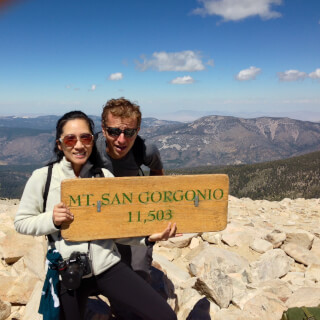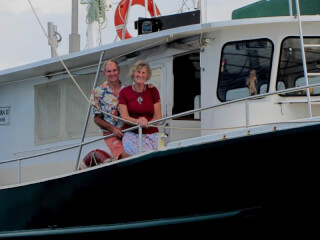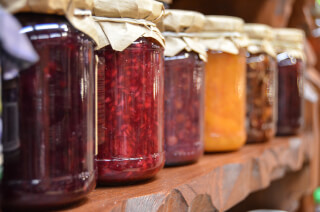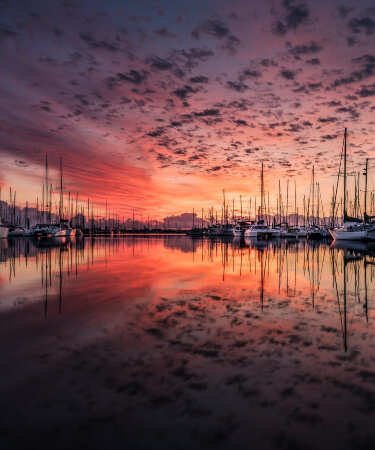Table of Contents

We Hate Hippos
A few months ago, Jan Wooller got in touch with us. She heard through Bill that we were interested in buying RJ Slocum and had many kind things to say about Bill and the boat.
As you can gather we have amassed quite a lot of experience over the years and know boats very well.
We can truthfully say that Rachel J Slocum is one of only a very small handful of yachts that we would be happy to go long distance sailing on. She’s incredibly well thought out and strongly built and will get you out of trouble no matter the conditions. We were green with envy over her forward facing sounder.
Her gorgeous dinghy would happily fit in as an exhibit in the Australian Wooden Boat Festival which is held in Tasmania every 2nd February. Boats built from Huon Pine are uncommon and very expensive and are highly sought after here.
Along with her sage advice, she sent along a copy of her book, “We Hate Hippos: Stories of a Sea Gypsy’s Life,” which is sold on The Coastal Passage. Andrew read the book in less than a week. It took me some time as I had other reading commitments, and I sure am glad I did.
What appeals to me most about her accounts is that the narrative is true to life. It hasn’t been skewed by appealing to an unknown audience. It has none of the distasteful choices made to draw eyeballs, to be click-bait, or to instruct. Since most sailing blogs and vlogs market/advertise vigorously to sustain a livelihood, I take their advice with a grain of salt. I prefer a realistic account, much like those also shared in The Coastal Passage, the most widely read cruising magazine in Australia.
I take the Hippo book (which I have come to refer to it with Andrew) as knowledge dispensed from a friend who is looking out for you.

Old School
When I read the short passage about preserving food for long passages, I got pretty excited. When one has to live without refrigeration (let alone deep freeze), I found some practical solutions laid out before me. Ironically, this isn’t new… these are techniques used many years ago before there was refrigeration.
So, it’s time to go old school.
Salt on butter
Allow butter to soften and pack into clean jars. level the top with a knife and sprinkle enough salt to cover completely. Butter can be kept for up to a year that way, even in the tropics.
Cheese in oil
Cut into blocks and place into an open jar. Fill the remaining space with oil.
Vaseline eggs
Coat each egg with Vaseline to seal the shell and place into plastic racks. Turn the eggs weekly to prevent spoilage. Eggs usable even at the end of five months.
Chloroform flour and pasta
Before sealing a plastic container of flour or pasta, place a film canister which contains a cotton ball soaked in chloroform. Since the lid of the film canister is punctured with a needle, the chloroform gas can escape slowly. This is the only foolproof method in preventing weevils.
Pressure cook meat (beef & lamb)
Use a twenty litre pressure cooker which allows you to prepare 16 450 gram jars at a time. Place uncooked cubed meat into the jars with a small amount of water. Place special one-use-only seals on top and cook the bottles according to the instructions with the canner (e.g., 12 lbs of pressure for over 80 minutes). The meat serves as a tasty ingredient in casseroles, curries and bolognaise sauce, and can be stored for years.
I turned to Andrew after reading these anecdotes, and in turn, he recognized that look in my eyes. It’s time for another culinary adventure!

Other lessons learned
We enjoyed various anecdotes about Jan and Nick’s lives over the past 30 years cruising and voyaging the high seas, including:
Replenishing the cruising kitty
While we have put together a reasonable budget, we cannot forecast for the unexpected and be 100% accurate. Even though they had set themselves up as well as they could, there were times where they needed to take a break from sailing and they were able to find jobs in Hong Kong, Japan, New Zealand and American Samoa.
Life in Japan
Andrew and I honeymooned in Japan. It was a place that long fascinated Andrew and we realized that our visit there was much too short. We’re hoping to have an extended stay there, just as Jan and Nick had. If the South Pacific islands don’t open up next year for cruisers, we may opt instead to sail to Hawaii and then on to Japan.
Misha, the bilge cat
One of the unknowns still lurking in our minds is whether Oreo and Xiao Long are suited for living on a boat. We were encouraged by how Misha and Tigger were cared for, especially when Jan and Nick were ashore and traveling six to seven weeks in twelve countries. There is a particularly dramatic account of Misha while under the care of Bill and his wife in Ushuaia when Jan and Nick visited Antarctica.
Exploring/hiking
Much like the authors, we love traveling and exploring, so the thought of being able to spend a month to six weeks backpacking is one of our goals of sailing. Sailing afforded them the opportunity to backpack through Thailand, Cambodia, Laos, New Zealand, South Africa, Kenya, Namibia, India and Nepal.

Learn More
If you are interested in reading more about Jan and Nick Wooller’s adventures over 37 years, some of the information is available online and offline including a diary spanning over 12 years within 95 pages!
- We Hate Hippo’s: Stories of a Sea Gypsy’s Life
- Diary aboard Yawarra II - Jan 2002 to Nov 2016
- Cruising World, Dec 2008
- The Coastal Passage, Jul-Aug 2010
- The Coastal Passage, Nov-Dec 2010
- Passage Maker, Jan 2012

Additional Resources
Other cruisers have shared their knowledge through books, courses and coaching. If you’re interested in any of these options, please check out the following links for related resources.
- The Boat Galley - Eating Well with a Tiny Fridge, Storing Food without Refrigeration
- Sailing Totem - Canning Meat on Board, Canning on Board - Papaya Chutney, Old School Skills for Sailors and Confinement, Precious Provisions
- Lin Pardey - Offshore Sailing Series, Care and Feeding of Sailing Crew
- Sailing Britican - Provisioning Dry Goods and Freezer Inventory, How to Free up Space in Your Galley
Thanks for reading!
Share Hippo Book with your friends:
Stay up to date with our content releases, by subscribing to our RSS Feed or follow us on Facebook and Instagram.
 If you would like to delve deeper into our adventure as it unfolds, please consider joining the Serenade Wind Crew. Our sister site provides more information on what it means to be part of the crew, unlock the pirate’s booty, and receive other exclusive access and benefits.The first 50 members have a gift waiting.
If you would like to delve deeper into our adventure as it unfolds, please consider joining the Serenade Wind Crew. Our sister site provides more information on what it means to be part of the crew, unlock the pirate’s booty, and receive other exclusive access and benefits.The first 50 members have a gift waiting. 